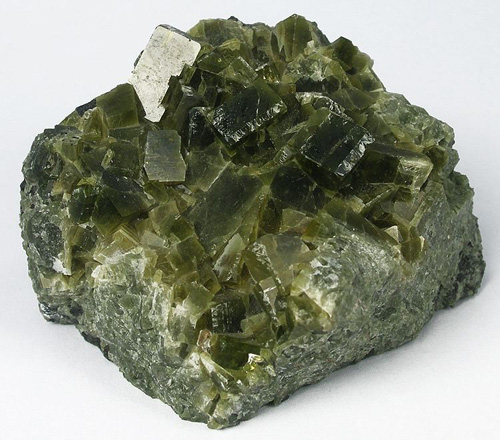The Mineral johannsenite

Johannsenite is a rare member of the pyroxene group that is isomorphous with Diopside and Hedenbergite. It often occurs with black manganese oxide dendrites on its surface. Johannsenite alters to become the pink mineral Rhodonite. Johannsenite is named in honor of Albert Johannsen (1871-1962), a petrologist and professor at the University of Chicago.
Chemical Formula
CaMnSi2O6
Color
Gray, brownish-gray, greenish-gray, olive-green, light blue, cream yellow. May also be banded.
Crystal System
Monoclinic
Properties
Streak
White |
Hardness
5 - 6 |
Transparency
Translucent to nearly opaque |
Specific Gravity
3.4 - 3.6 |
Luster
Vitreous to greasy |
Cleavage
1,2 - prismatic at cleavage angles of 87º and 93º (Characteristic of minerals in the pyroxene group). May also exhibit parting in one direction. |
Fracture
Uneven to splintery |
Tenacity
Brittle |
Noteworthy Localities
Johannsenite is found in slender acicular crystals and in banded masses at Monte Civillina, Recoaro, Italy; and in olive green crystals in the North Mine, Broken Hill, New South Wales, Australia. Brown crystals associated with Rhodochrosite come from the Uchucchaqua Mine, Oyon Province, Peru. In the U.S., the premier locality is the Iron Cap mine, Landsman Camp, Graham Co., Arizona. Other occurrences are Hanover, Grant County, New Mexico; and Franklin, Sussex Co., New Jersey.
Distingushing Similar Minerals
The localities and crystal habits of this mineral can distinguish from most minerals.